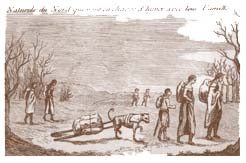
The Illinois were semi-sedentary and moved between three types of settlements during the year. Summer villages, located near rivers, were inhabited in April and May--during the planting of maize--and again from mid-July to mid-October when the maize crops were harvested. The summer villages were re-occupied from year to year and were quite large, some including as many as 350 mat-covered longhouses. Summer hunting camps were established in the prairies in June and July during communal bison hunts. The hunting camps were occupied briefly and consisted of temporary bark-covered lodges.
Indians of the north leaving on a winter hunt with their families. (drawing by M. Le Page Du Pratz, 1758)
Winter villages were located in river bottoms where good hunting was expected, often many kilometers away from the summer villages. They were usually inhabited from mid-October to the end of March. To ensure good hunting, the winter villages were smaller than the summer villages and contained fewer people. Typically, each winter village contained about 5-20 oval, mat-covered lodges called wigwams. However, larger winter villages were sometimes constructed when the Illinois were in danger of being attacked.![]()
|
|
Copyright © 2000 Illinois State Museum
